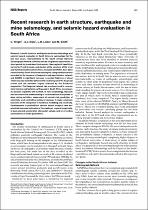 ResearchSpace
ResearchSpace
Recent research in earth structure, earthquake and mine seismology, and seismic hazard evaluation in South Africa
JavaScript is disabled for your browser. Some features of this site may not work without it.
- ResearchSpace
- →
- Research Publications/Outputs
- →
- Journal Articles
- →
- View Item
| dc.contributor.author |
Wright, C

|
en_US |
| dc.contributor.author |
Kijko, AJ

|
en_US |
| dc.contributor.author |
Linzer, LM

|
en_US |
| dc.contributor.author |
Smith, M

|
en_US |
| dc.date.accessioned | 2007-03-16T06:35:10Z | en_US |
| dc.date.accessioned | 2007-06-07T10:10:22Z | |
| dc.date.available | 2007-03-16T06:35:10Z | en_US |
| dc.date.available | 2007-06-07T10:10:22Z | |
| dc.date.issued | 2003-07 | en_US |
| dc.identifier.citation | Wright, C, et al. 2003. Recent research in earth structure, earthquake and mine seismology, and seismic hazard evaluation in South Africa. South African Journal of Science, vol 99, July, pp 389-394 | en_US |
| dc.identifier.issn | 0038-2353 | en_US |
| dc.identifier.uri | http://hdl.handle.net/10204/1948 | en_US |
| dc.identifier.uri | http://hdl.handle.net/10204/1948 | |
| dc.description.abstract | Research in earth structure, earthquake and mine seismology, and seismic hazard evaluation in South Africa is summarized for the last four years. Improvements to the South African National Seismograph Network (SANSN) include the gradual replacement of short-period by broad-band instruments. New regional travel-time curves for P and S waves, and models of the structure of the crust and mantle beneath southern Africa to depths of 800 km, have been constructed by South African seismologists using earthquake data recorded by the temporary Kaapvaal broad-band seismic network and SANSN. A significant increase in crustal thickness of about 10km was also identified between the southern part of the Kaapvaal craton and the northern region affected by the Bushveld magmatism. The Kaapvaal network has also been used to relocate mine tremors and tectonic earthquakes in South Africa to compare its location capability with SANSN. In mine seismology, research has focused on the understanding of rock behaviour in response to deep mining activities, assessment of seismic risk, prediction of seismicity, and controlling rock burst damage. A major emphasis has been on the integration of numerical modelling and seismicity. Developments in probabilistic seismic hazard analysis have emphasized improved estimates of the maximum regional magnitude, of peak ground acceleration attenuation values, and on providing uncertainties in model parameters. | en_US |
| dc.format.extent | 490060 bytes | en_US |
| dc.format.mimetype | application/pdf | en_US |
| dc.language.iso | en | en_US |
| dc.publisher | Academy of Science of South Africa | en_US |
| dc.rights | Copyright: 2003 Academy of Science of South Africa | en_US |
| dc.subject | Earth structures | en_US |
| dc.subject | Earthquakes | en_US |
| dc.subject | Mine seismologies | en_US |
| dc.subject | Seismic hazard evaluations | en_US |
| dc.title | Recent research in earth structure, earthquake and mine seismology, and seismic hazard evaluation in South Africa | en_US |
| dc.type | Article | en_US |
| dc.identifier.apacitation | Wright, C., Kijko, A., Linzer, L., & Smith, M. (2003). Recent research in earth structure, earthquake and mine seismology, and seismic hazard evaluation in South Africa. http://hdl.handle.net/10204/1948 | en_ZA |
| dc.identifier.chicagocitation | Wright, C, AJ Kijko, LM Linzer, and M Smith "Recent research in earth structure, earthquake and mine seismology, and seismic hazard evaluation in South Africa." (2003) http://hdl.handle.net/10204/1948 | en_ZA |
| dc.identifier.vancouvercitation | Wright C, Kijko A, Linzer L, Smith M. Recent research in earth structure, earthquake and mine seismology, and seismic hazard evaluation in South Africa. 2003; http://hdl.handle.net/10204/1948. | en_ZA |
| dc.identifier.ris | TY - Article AU - Wright, C AU - Kijko, AJ AU - Linzer, LM AU - Smith, M AB - Research in earth structure, earthquake and mine seismology, and seismic hazard evaluation in South Africa is summarized for the last four years. Improvements to the South African National Seismograph Network (SANSN) include the gradual replacement of short-period by broad-band instruments. New regional travel-time curves for P and S waves, and models of the structure of the crust and mantle beneath southern Africa to depths of 800 km, have been constructed by South African seismologists using earthquake data recorded by the temporary Kaapvaal broad-band seismic network and SANSN. A significant increase in crustal thickness of about 10km was also identified between the southern part of the Kaapvaal craton and the northern region affected by the Bushveld magmatism. The Kaapvaal network has also been used to relocate mine tremors and tectonic earthquakes in South Africa to compare its location capability with SANSN. In mine seismology, research has focused on the understanding of rock behaviour in response to deep mining activities, assessment of seismic risk, prediction of seismicity, and controlling rock burst damage. A major emphasis has been on the integration of numerical modelling and seismicity. Developments in probabilistic seismic hazard analysis have emphasized improved estimates of the maximum regional magnitude, of peak ground acceleration attenuation values, and on providing uncertainties in model parameters. DA - 2003-07 DB - ResearchSpace DP - CSIR KW - Earth structures KW - Earthquakes KW - Mine seismologies KW - Seismic hazard evaluations LK - https://researchspace.csir.co.za PY - 2003 SM - 0038-2353 T1 - Recent research in earth structure, earthquake and mine seismology, and seismic hazard evaluation in South Africa TI - Recent research in earth structure, earthquake and mine seismology, and seismic hazard evaluation in South Africa UR - http://hdl.handle.net/10204/1948 ER - | en_ZA |





